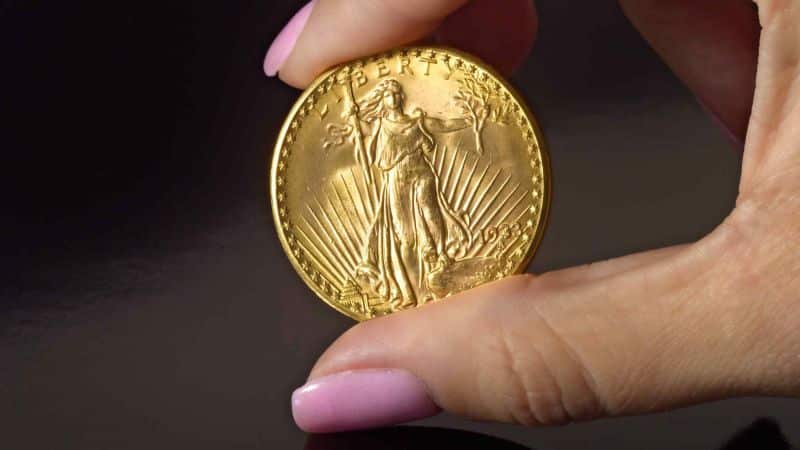Imagine holding a piece of history in your hands, one so rare and shrouded in mystery that it captures the imagination of collectors and historians alike. The 1933 Double Eagle coin is just such a treasure. Minted during economic upheaval, this gold coin represents the last of its kind, symbolizing an era that would change forever. With only a single coin legally allowed to be owned by individuals, its allure isn’t just in its beauty, but in its exclusivity and the intriguing stories surrounding it.
The journey of the 1933 Double Eagle is a tale woven through decades, involving a king’s vast collection, a mistaken export license, and a world at war delaying diplomatic efforts for its return. Sold for a record-breaking $18.9 million in June 2021, this coin’s value transcends its weight in gold, embodying a rich narrative of history, rarity, and the lengths to which collectors will go to own a piece of the past. As you delve into the story of the 1933 Double Eagle, you’re embarking on an adventure that spans continents and centuries, inviting you to uncover the secrets of one of the world’s most famous coins.
Designer Augustus Saint-Gaudens
Augustus Saint-Gaudens, renowned for his significant contributions to American sculpture and numismatics, left an indelible mark with his design of the 1933 Double Eagle, elevating it to the most valuable rare coin for many collectors. His artistic journey began with a commission in New York, creating iconic monuments and sculptures, including the General Sherman Monument and several bronze tributes to President Abraham Lincoln. Saint-Gaudens’ work exemplifies artistic ingenuity and uniqueness, traits that flowed seamlessly into his numismatic designs.
Commissioned by President Theodore Roosevelt to redesign America’s coins, Saint-Gaudens embraced the challenge, embedding the nation’s identity into his creations. The 20 Gold Double Eagle, his final masterpiece before he died in 1907, emerged as a perfect amalgamation of beauty and nationalism, capturing the essence of American pride during the transition. Saint-Gaudens’ design philosophy ensured that every detail, from the flowing lines to the symbolic imagery, conveyed a story, cementing the Double Eagle’s place as a rare gold coin of unmatched allure.
Numismatic experts and enthusiasts frequently hail the Double Eagle designed by Saint-Gaudens as the pinnacle of coinage artistry, emphasizing its position as a cornerstone of American numismatic history. The coin’s rarity and the story of its inception contribute to its status as a highly sought-after treasure among collectors. The 1933 Double Eagle, in particular, symbolizes a critical moment in economic history and the zenith of Saint-Gaudens’ career, blending artistic excellence with historical significance.
Executive Order 6102
After exploring the 1933 Double Eagle’s artistic and historical significance, you’ll find the governmental pivot that further amplified its mystique and scarcity. Executive Order 6102, issued by President Franklin D. Roosevelt in 1933, played a pivotal role in shaping the narrative and fate of gold coins in the United States, particularly affecting the 1933 Double Eagle. This order, coupled with subsequent legislative actions, sought to stabilize the American economy during the Great Depression but also inadvertently elevated this coin’s status to one of the most valuable rare coins in numismatics.
Gold Reserve Act
After Executive Order 6102 mandated the return of gold coins, bullion, and certificates to the Federal Reserve, Congress passed the Gold Reserve Act in 1934, reinforcing and expanding gold ownership and usage restrictions. This act formally outlawed the private possession and circulation of gold coins for general use, sparing only those deemed of collector value. It decreed that gold was no longer legal tender, compelling citizens to exchange their gold coins for other forms of currency. Under the shadow of this act, the 1933 gold Double Eagles, already struck and ready for circulation, faced a doomed fate. Most were ordered to be melted down, marking a significant moment in U.S. history where a coin transitioned from a potential everyday asset to a rare gold coin of immense collector interest.
While the Gold Reserve Act intended to strengthen the economy by moving away from the gold standard, its impact on numismatics was unintended yet profound. The act ensured that surviving 1933 Double Eagles would become exceedingly rare, encapsulating a unique historical narrative that transcends their gold value. The rarity was compounded when a few escaped into private hands despite efforts to melt down the coins, becoming legendary treasures within the collecting world. Today, those few 1933 Double Eagles that survived embody the pinnacle of coin artistry and a complex tale of economic policy, making them among the most sought-after and storytelling-rich pieces in numismatics.
1933 Double Eagle Scarcity
The 1933 Double Eagle’s scarcity has elevated its status, making it not only a symbol of American artistry and history but also one of the most valuable rare coins in the numismatic world. The intricate tale of its scarcity begins with government orders that inadvertently boosted its value and appeal among collectors and investors alike.
Melted Down Coins
Initially, after President Franklin D. Roosevelt’s Executive Order 6102 and the subsequent Gold Reserve Act of 1934, the fate of gold coins, particularly the 1933 Double Eagles, took a crucial turn. These legislations not only outlawed private possession of gold in an attempt to stabilize the economy during the Great Depression but also led to the melting down of a vast majority of these coins. As a result, the already manufactured 1933 Double Eagle coins, which were never officially circulated, faced near extinction. This mass melting significantly contributed to the scarcity of the 1933 Double Eagle coins, transforming surviving pieces into rare treasures. The government’s intervention, aimed at economic recovery, inadvertently created what is now known as the most valuable rare coin in history.
Remaining Coins
Despite the government’s efforts to melt down the 1933 Double Eagles, a few miraculously survived, further augmenting their rarity and value. The saga includes two coins intentionally spared and housed in the US National Numismatic Collection for their historical importance. In contrast, another ten are securely stored in Fort Knox’s United States Bullion Depository for preservation. Additionally, a single coin found its way into private hands, fetching a staggering $7.59 million in 2002, a value that has since escalated, underscoring its status as a rare gold coin of unparalleled worth. This coin again made headlines when it sold for an eye-watering $18.9 million in June 2021, cementing its reputation as the most expensive coin ever sold at auction. These remaining coins, each with a story to tell, underscore the 1933 Double Eagle’s remarkable journey from a potential casualty of economic policy to a celebrated icon in the numismatic and investment worlds.
Recovered & Melted Stolen Coins
Among the most intriguing chapters in the saga of the 1933 Double Eagle is the fate of the stolen coins, which were plucked from the brink of obliteration and thrust into the spotlight of the numismatic world. In the tumultuous 1930s, while most of these coveted pieces were destined to be melted down by the Gold Reserve Act of 1934, a small but significant number eluded destruction through illicit means.
Initially, 445,500 specimens of this rare gold coin had been minted with the expectation that they would circulate and contribute to the economy. However, the swift policy changes meant they were never officially issued. In a daring twist of fate, 20 of these coins were stolen and subsequently found their way into the hands of eager collectors, setting the stage for a decades-long odyssey of recovery.
The United States Secret Service, tasked with safeguarding the nation’s financial integrity, relentlessly sought to recover these purloined treasures. Nine of the recovered 1933 Double Eagles met their end as they were melted down, in line with their original fate, reinforcing the scarcity and allure of the remaining specimens. As a result, this dramatic tale of survival against the odds has cemented the 1933 Double Eagle’s status as the most valuable rare coin in the eyes of collectors and historians alike.
At the heart of the recovered specimens is the Weitzman Specimen, notable for being the only one legally available for private ownership. This particular coin’s journey from production through theft to legal auction encapsulates the tumultuous history of the 1933 Double Eagles and highlights their desirability as objects of immense historical and monetary value.
Drawing attention to the broader implications, the saga of the 1933 Double Eagle, from ambition to oblivion and finally to recovery, underscores a fascinating juncture in American numismatic history, where law, economy, and passion intertwine.
Record Sales
The 1933 Double Eagle is a paramount example of what passionate collectors and historians consider the epitome of numismatic treasures. Transitioning from a piece of history to a highly coveted collector’s item, this rare gold coin’s journey through auctions has only cemented its legacy as one of the most valuable rare coins in the world. Two significant sales highlight its unparalleled value and the frenzy it can generate among enthusiasts and investors.
Stack Bowers 2002 Sale
In July 2002, a momentous event in numismatics unfolded when one of the 1933 Double Eagle coins was auctioned by Stacks Bowers Galleries in New York. The sale notably set a record, with the coin fetching $7.59 million, almost twice the previous record held by any coin. This transaction included the hammer price, a buyer’s premium, and an additional amount to monetize the coin, converting it into legal currency. The total sum achieved underscored the coin’s intrinsic and historical value and solidified its status as a centerpiece of numismatic collections worldwide. This sale revealed the intense intrigue and value placed on rare gold coins, particularly those with storied pasts.
Sotheby’s 2021 Sale
Fast forward to June 2021, and the 1933 Double Eagle coin shatters previous records yet again. Sotheby’s orchestrated the sale of this elusive coin, marking another landmark moment in the numismatic field. This time, the coin was sold for an astonishing $18.9 million, becoming the most valuable gold rare coin ever auctioned. The sheer scale of the sale not only highlighted the coin’s rarity and desirability and its significance as a historical artifact. It emanated a sense of prestige, drawing collectors who viewed its acquisition as a milestone in their collecting endeavors. The Sotheby’s sale further established the 1933 Double Eagle’s unrivaled position in the world of rare and valuable coins, commanding attention and awe from collectors and the general public alike.
In both instances, the sale of the 1933 Double Eagle transcended mere transactions. They were events celebrated by numismatists and historians for the coin’s intriguing backstory, artistic merit, and investment potential. The record prices achieved at these auctions reflect the coin’s tangible value and its symbolic significance as a testament to the enduring allure of collecting. With each sale, the 1933 Double Eagle further entrenches its legacy as the pinnacle of numismatic treasures, captivating the imaginations of enthusiasts around the globe.
An Amazing Rare Coin History
Diving into the world of rare coins, the 1933 Double Eagle stands out as a beacon of numismatic history and value. Its journey from a nearly lost artifact to a record-breaking auction piece offers a compelling narrative for collectors and enthusiasts alike. The coin’s blend of artistic beauty, historical significance, and legal intrigue makes it a unique collectible treasure. With the 2021 sale setting a new benchmark for the value of rare coins, the 1933 Double Eagle has not only captivated the attention of the numismatic community but also highlighted the potential for remarkable discoveries and investments in this field. Whether you’re a seasoned collector or just starting, the story of the 1933 Double Eagle serves as an inspiring example of the enduring appeal and value of rare coins.






